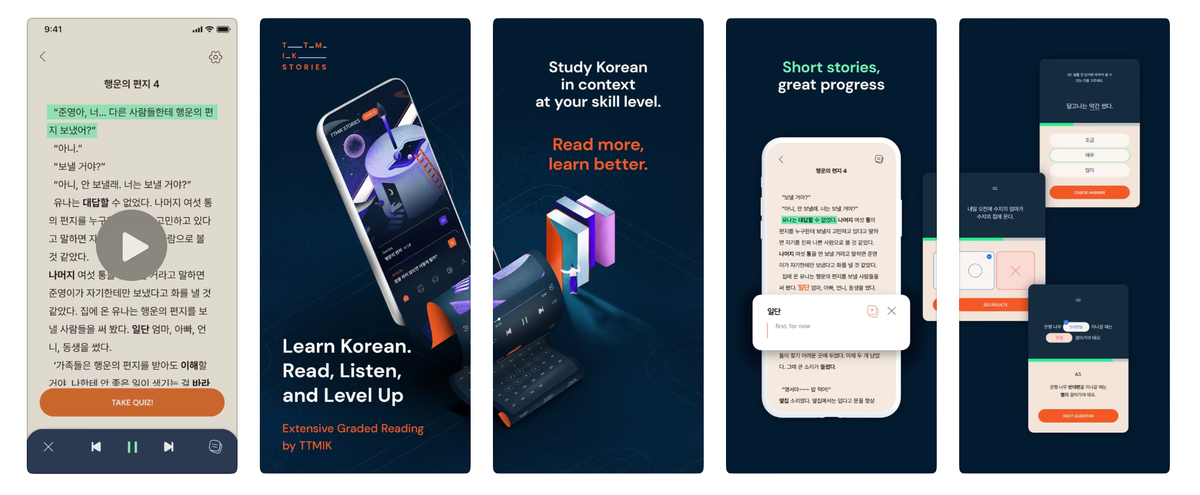5 Practical Ways to Boost Your Korean Reading and Vocabulary Retention

Studying Korean through reading can be a game-changer for your language progress—especially when you pair engaging material with effective learning techniques. Whether you're scrolling through webtoons, flipping through grammar notes, or enjoying short stories in an app like TTMIK Stories, the key is how you read and what you do afterward to really lock in the words and expressions you encounter.
Below, you’ll find five practical strategies to help you remember more of the vocabulary and phrases you come across in Korean texts. Keep in mind that these are simply suggestions you can use with any reading material; they’re not features built into TTMIK Stories or any specific platform.
1. Summarize in Korean—Out Loud if You Can
Rather than immediately switching to social media or another task when you finish reading, take a brief moment to mentally rephrase the text in Korean. This could be as simple as a few sentences describing the main points, or an out-loud explanation of what happened in the story. By doing so:
- You practice recalling key vocabulary and grammar points in your own words.
- You strengthen the neural pathways associated with those new expressions.
How This Helps Your Vocabulary
When you try to summarize in Korean, you’ll naturally search your memory for the words you just saw. It’s a quick, free way to reinforce what you’ve learned—no fancy tools required!
2. Turn New Words into Personalized Notes
Reading in Korean is an excellent opportunity to discover fresh words or expressions. But it’s easy to forget them if you don’t review. Create a simple habit:
- Keep a small notebook or note-taking app handy.
- Jot down words and phrases that catch your eye.
- Write one example sentence using each expression in Korean.
How This Helps Your Vocabulary
By putting words into your own sentences, you connect them to real-life contexts or familiar situations. This step makes the expressions more memorable and easier to recall later.
3. Use Active Recall Before Checking the Text
Reading the same passage multiple times can be beneficial, but you get the biggest memory boost when you try to recall details before looking again. Here’s how:
- Close your book/app after reading.
- After a short break, see how much you remember—from plot points to specific words.
- Revisit the text only when you hit a blank.
How This Helps Your Vocabulary
Each moment you spend retrieving a forgotten word on your own strengthens your memory. This method is called active recall, and it’s backed by research as one of the most effective ways to learn.
4. Incorporate New Expressions into Everyday Practice
It’s one thing to recognize a word in a story and another thing entirely to use it. After you’ve encountered new phrases in your reading:
- Challenge yourself to use one or two of them in a short journal entry, social media post, or conversation.
- Even if it feels awkward at first, using new expressions in real-life contexts cements them in your active vocabulary.
How This Helps Your Vocabulary
When your brain sees that a certain word actually comes in handy (not just in a fictional story!), it prioritizes remembering it.
5. Compare and Connect via Mind Maps or Story Boards
If the text you’re reading is part of a series—like sequential chapters, multiple short stories, or webtoon episodes—take a moment to sketch a simple mind map:
- Write down main events, character names, or key vocabulary.
- Draw lines to connect similar themes or expressions across chapters/stories.
How This Helps Your Vocabulary
By grouping related ideas, your brain sees logical links between expressions, making them easier to recall in the future. It’s like creating a mini-Korean universe of your own.
Why TTMIK Stories?
TTMIK Stories is a graded Korean reading app that provides diverse short stories at various skill levels. It offers curated vocabulary and reading tips, but it does not come with built-in features for summarizing, creating quizzes, or mind mapping. That’s where you can take the initiative with the strategies above—use the stories as a springboard for active learning, not just passive reading.


